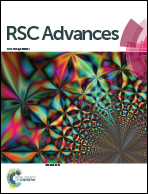High supercapacitive performance of Ni(OH)2/XC-72 composite prepared by microwave-assisted method†
Abstract
A 60 wt% Ni(OH)2/XC-72 composite was synthesized via a facile and rapid microwave-assisted method in an ethylene glycol medium. Transmission electron microscopy images show that Ni(OH)2 is uniformly dispersed on XC-72 and that when carbon nanotubes (CNTs) are added as a conductive agent, they construct a three-dimensional (3-D) network together with the Ni(OH)2 particles and XC-72. The composite demonstrates a specific capacitance of 1296 F g−1 at a scan rate of 2 mV s−1 and 1560 F g−1 at a current density of 1 A g−1 in 6 M KOH aqueous solution, and its retention of specific capacitance is 71% after 1000 cycles. This can be attributed to XC-72 being an excellent support and CNTs with high aspect ratio and good conductivity to construct a 3-D conductive network. This excellent electrochemical performance makes the Ni(OH)2/XC-72 composite promising as an electrode material for a supercapacitor.


 Please wait while we load your content...
Please wait while we load your content...